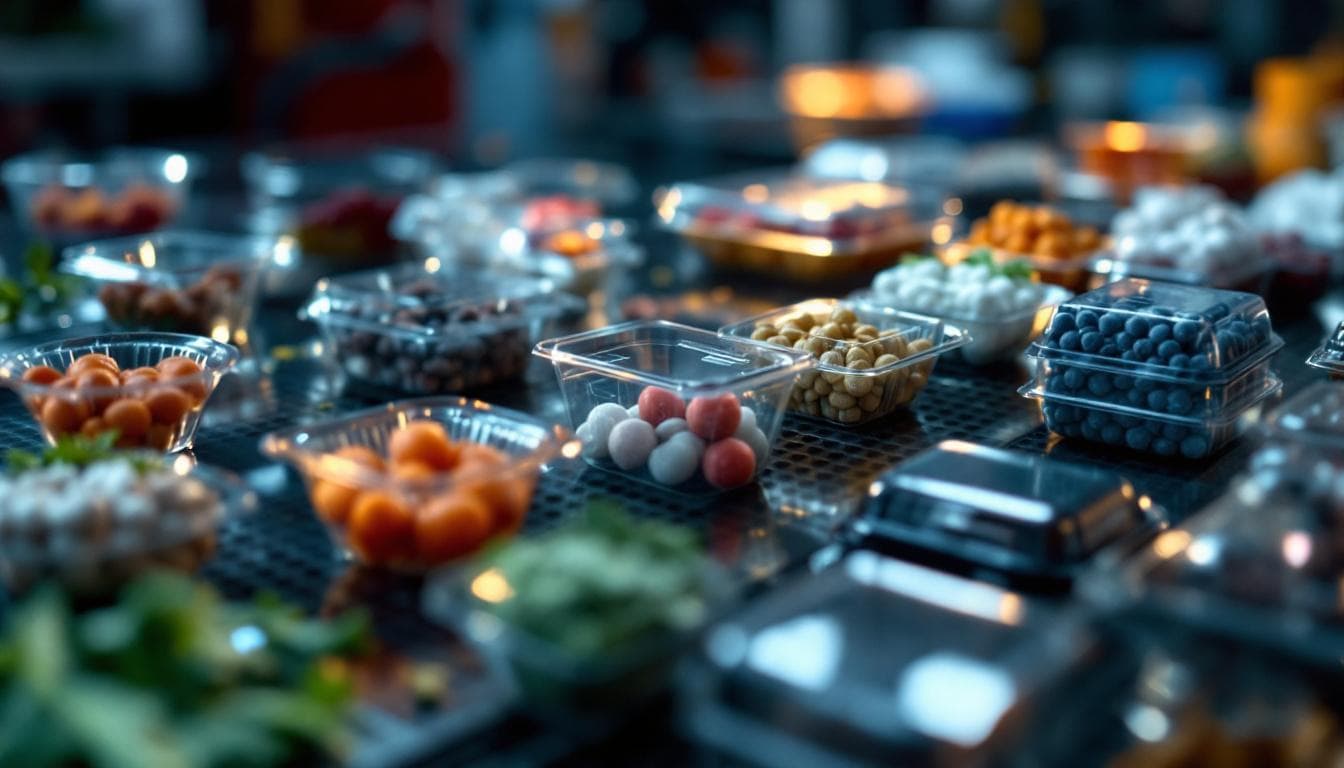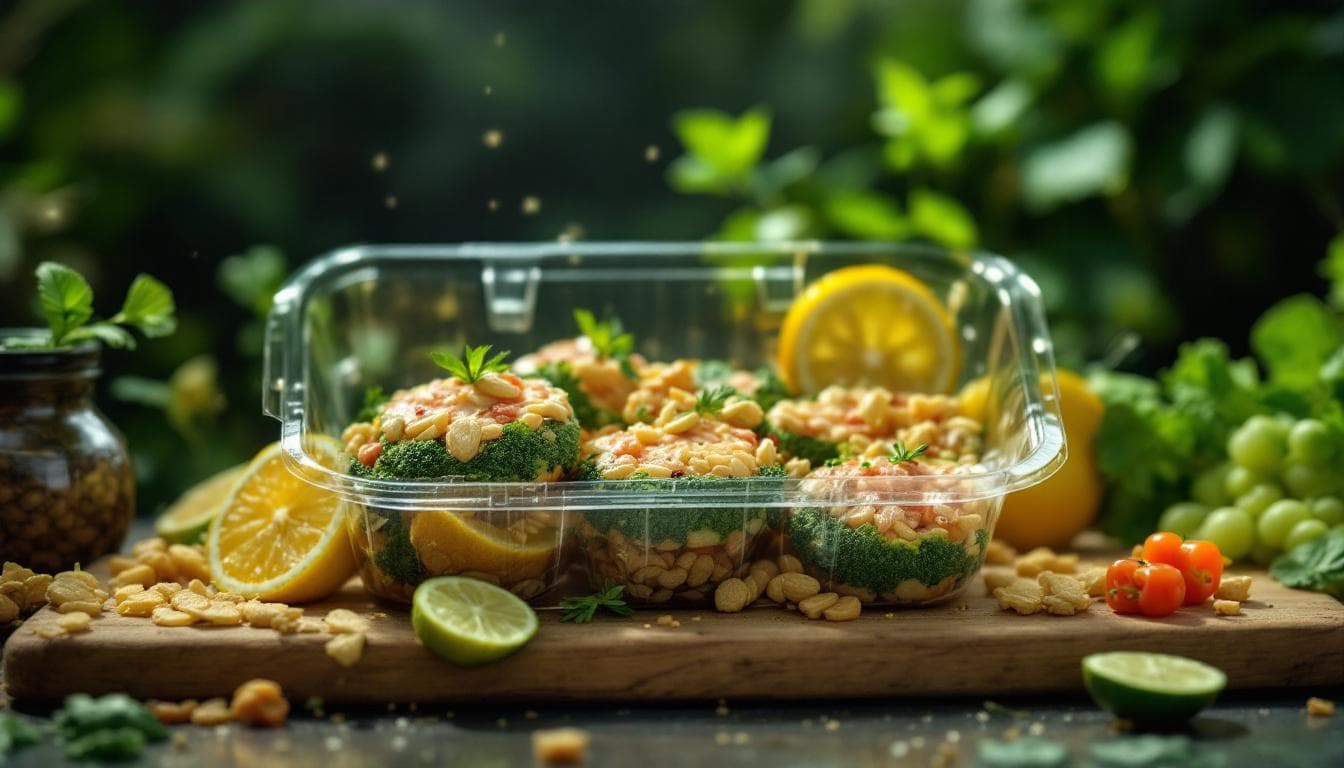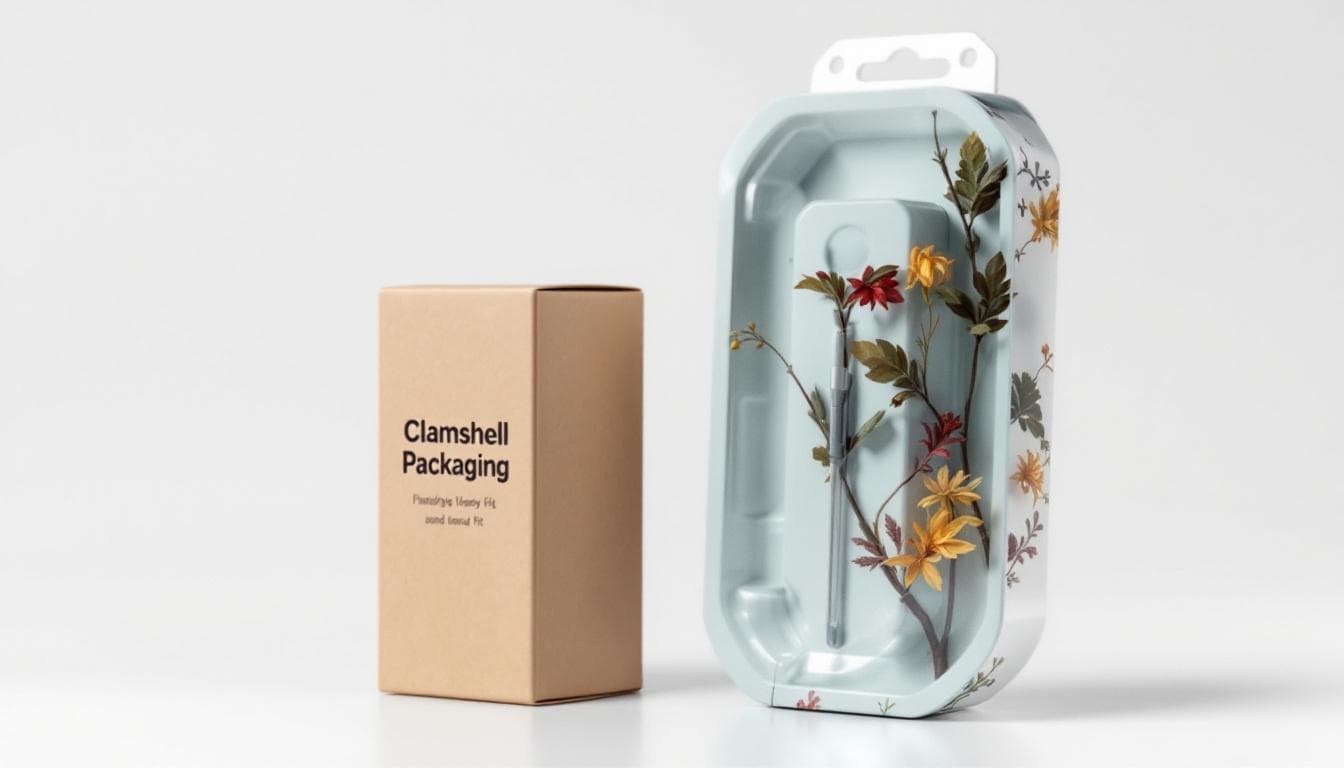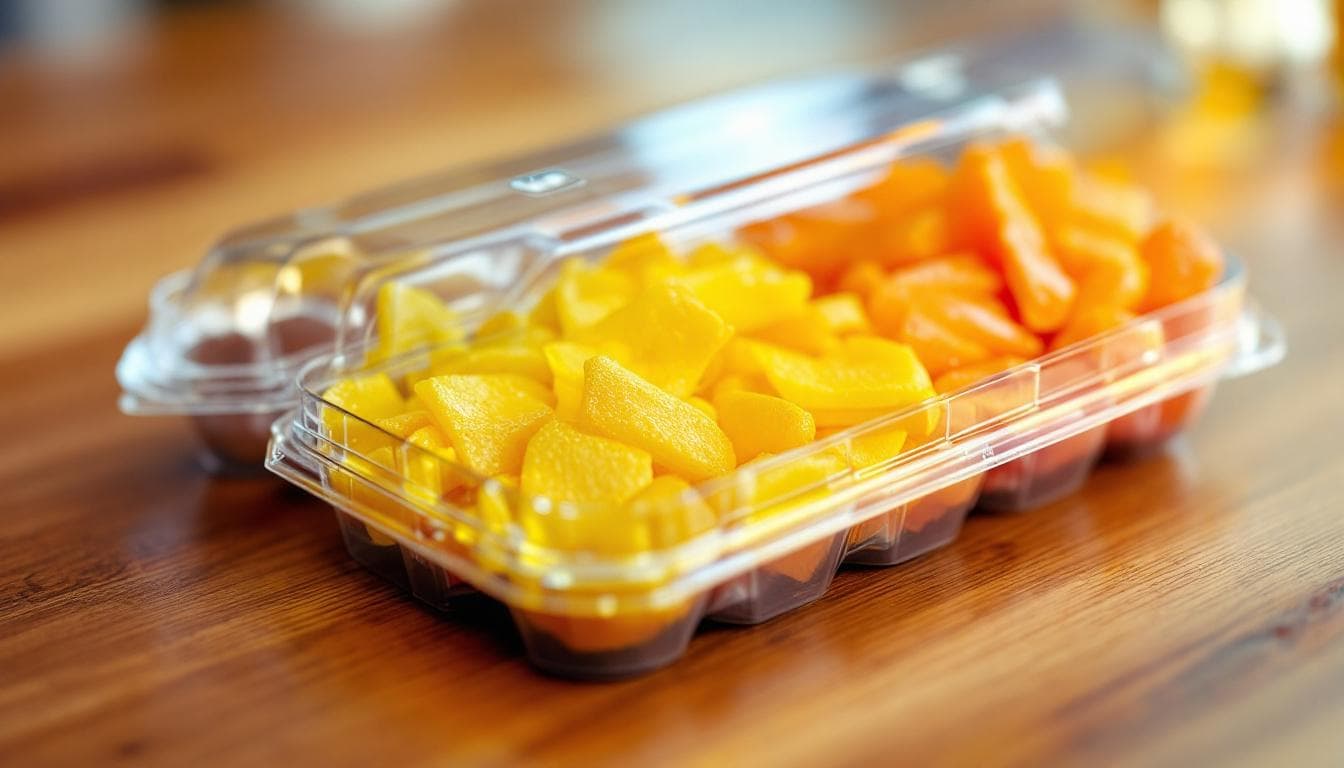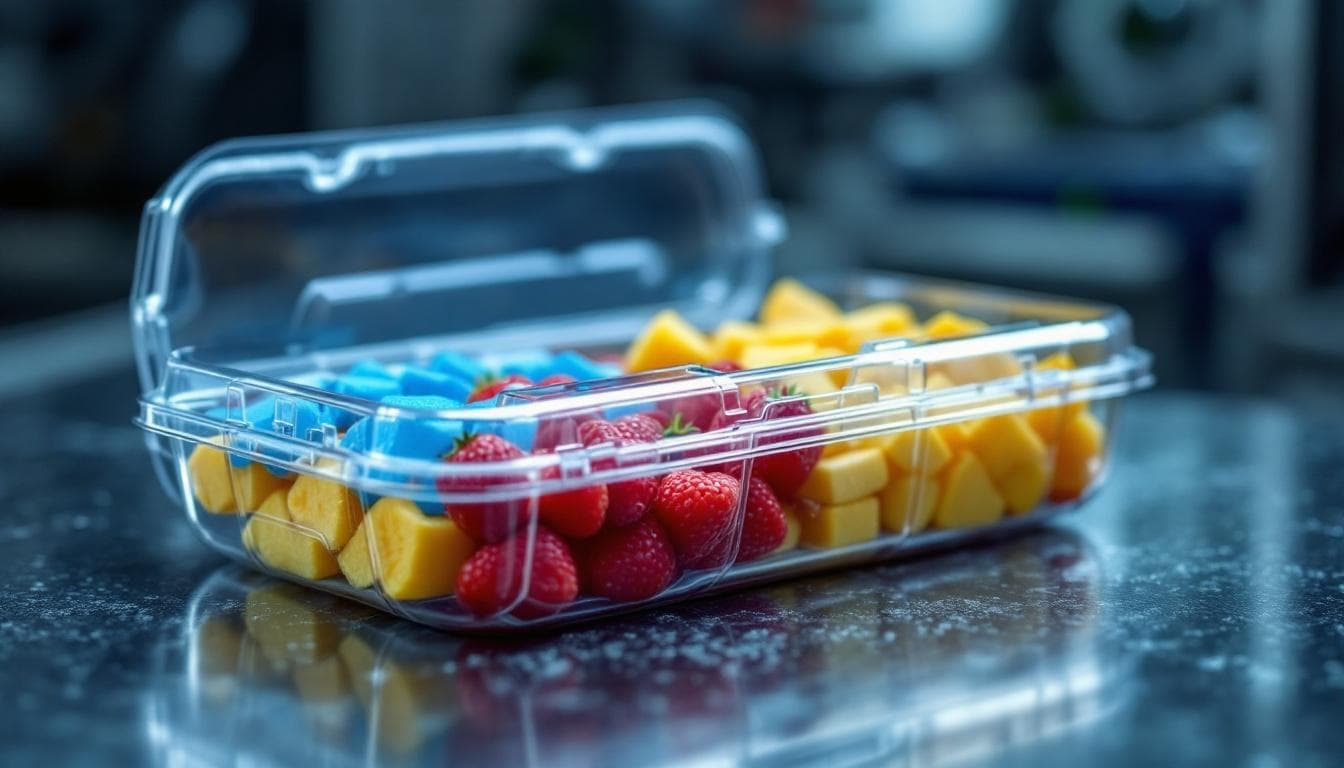
Types of Clamshell Packaging: Pros and Cons for 2025
What makes a package both protective and easy to shop? Clamshell packaging is a clear, hinged container that opens like a shell, used for food, toys, and electronics. It shows the product from all sides, keeps it secure, and stacks well in stores.
Retailers like clamshells because they sell the product, not just the package. Visibility builds trust, and tamper cues help with safety. Done right, they also speed up stocking and reduce returns.
Sustainability is changing the picture. You’ll see more recycled plastics, paperboard styles, molded fiber, and plant-based options. Brands want less waste and a smaller footprint, without losing strength or clarity.
In this guide, we’ll compare the main types and materials, with their pros and cons. You’ll see how clear PET and rPET boost display, where PP fits for durability, when paper or fiber makes sense, and why some PVC options are falling out of favor. We’ll also touch on “mock” clamshells that use less material and ship flat.
Picking the right clamshell packaging can lift sales or cut waste, sometimes both. If your goal is visibility and security, learn how boosting shelf appeal with clamshell packaging works in practice. If sustainability is key, we’ll note what actually recycles or composts in the real world.
By the end, you’ll have a simple checklist to match your product with the best style and material. Fewer returns, fewer headaches, and a package customers can open without tools. Let’s start with the types and how they perform in the aisle and after the sale.
Exploring Plastic-Based Types of Clamshell Packaging
Plastic clamshell packaging stays popular because it is affordable, clear, and versatile. Most retail-ready clamshells use one of four plastics. Each type balances clarity, strength, and cost in a different way. The right choice depends on what you are selling, how it is stored, and whether you need heat resistance or crystal-clear display.
If you need a quick refresher on fit and format before choosing the material, see the basics in What is clamshell packaging?
PET Clamshell Packaging: The Clear Visibility Champion
PET is the clear favorite for retail display. It is lightweight and naturally transparent, which makes products look fresh and clean on the shelf. You will see PET clamshell packaging used for berries, mixed fruit trays, salad kits, cupcakes, and bakery clamshells that need strong visual appeal.
Why brands pick PET:
- Standout clarity: Shoppers see color, texture, and quality without glare or tint.
- Freshness help: Good moisture barrier helps keep produce and baked goods from drying out.
- Recyclable: Often accepted curbside, especially when made from rPET.
- Cost-effective: Efficient to form, stack, and ship.
Points to weigh:
- Fossil fuel-based: It still uses petroleum, even when recycled content is high.
- Not biodegradable: It does not break down in nature.
- Recycling access varies: Some areas accept PET clamshells, others do not, due to labels or food residue.
Use PET when visibility drives sales and you need light protection from moisture. Compared with PP, PET wins for clarity but loses for heat. Compared with HDPE, PET wins for display but is less rugged for rough handling.
Example: A berry clamshell with vent holes that shows off color and keeps condensation in check.
PP Clamshell Packaging: Built for Heat and Durability
PP is the sturdy option that can handle heat. It is slightly opaque, with a softer look than PET. It works well for hot foods, deli items, and microwavable meals that need to stay rigid after reheating.
Why teams choose PP:
- Heat resistant: Withstands microwave and hot-fill without warping.
- Tough hinge performance: Hinges resist cracking from repeated opening.
- Lightweight: Durable without extra weight.
Points to weigh:
- Lower transparency: The cloudy look reduces visual pop on shelf.
- Recycling is limited: Some communities accept PP, many do not.
Use PP when function beats display. Think meal prep containers, takeout clamshells, and hot bar items. Compared with PET, PP trades sparkle for heat stability. Compared with PVC, PP is safer to handle and easier to source, but it will not match PVC’s rigid form for complex shapes.
Example: A microwave-safe lunch container that keeps its shape after reheating.
PVC Clamshell Packaging: Strong but Environmentally Tricky
PVC has a long history in clamshell packaging for tools, small electronics, and toy multipacks. It forms sharp detail and holds complex shapes well. The material is rigid and clear, so packages feel sturdy in hand.
Why some still use PVC:
- Good formability: Captures detail for contoured cavities and insert holds.
- Strong and rigid: Resists bending and helps deter tampering.
Points to weigh:
- Chlorine content: Raises concerns during production and end of life.
- Recycling challenges: Sorting issues and risk of toxic byproducts.
- Safety and brand perception: Many retailers now prefer other plastics.
PVC is fading as brands move to PET or PP for a cleaner footprint and better recycling paths. It can still show up in hardware and toy aisles where shape control is essential, but it is less common each year.
Example: A rigid clamshell for a screwdriver set with molded slots for each piece.
HDPE Clamshell Packaging: Tough and Moisture-Proof
HDPE trades clarity for performance. It is opaque or translucent, very strong for its weight, and has an excellent moisture barrier. It excels when product protection matters more than shelf display.
Why teams pick HDPE:
- Impact resistant: Handles drops and rough handling well.
- Moisture barrier: Keeps out water and vapor.
- Widely recyclable: Often accepted with milk jugs and detergent bottles.
Points to weigh:
- Limited visibility: You lose the clear showcase effect.
- Less premium look: Not ideal for impulse buys where presentation matters.
Use HDPE for dairy, bulk foods, or hardware where you prioritize durability. Compared with PET, HDPE is stronger in rough conditions but cannot display product details. Compared with PP, HDPE is similar in weight and strength, but PP wins for heat.
Example: A sturdy food tub or component case that protects parts during shipping and storage.
Quick Comparison: Picking the Right Plastic
Use this simple guide to match material with your goal.
- Need to sell the look: Choose PET for high clarity and fresh feel.
- Need heat performance: Choose PP for microwavable or hot-fill items.
- Need rigid, detailed shapes: PVC does the job but consider PET for a cleaner profile.
- Need strength and moisture control: Choose HDPE when protection comes first.
For most food and retail uses, PET and PP cover the majority of needs. PVC is on the decline due to environmental concerns. HDPE steps in when you must protect the product and do not need full visibility.
Bottom line: Plastic clamshell packaging remains the most common because it balances cost, speed, and performance. Pick the resin that matches the job, then confirm local recycling rules and any retailer standards before you scale.
Sustainable Alternatives: Plant-Based Clamshell Packaging Options
Consumer demand in 2025 is clear. People want packaging that protects food, looks good, and does not leave a mess behind. Plant-based clamshell packaging uses renewable resources, cuts plastic use, and can return to the earth in compost. If you need to balance performance with lower impact, these options are worth a close look. For broader context on why this matters during transit and end of life, see how brands are using renewable packaging solutions to lower emissions.
Sugarcane Bagasse Clamshell Packaging: Natural and Compostable
Bagasse is the dry fiber left after pressing sugarcane for juice. Instead of burning or discarding it, manufacturers mold it into sturdy clamshells and trays. The result is a compostable container made from a fast-growing crop byproduct, not petroleum. It works well for takeout, catering, and events where speed, stackability, and clean disposal matter.
What makes bagasse stand out:
- Toxin-free: Made without PFAS coatings when sourced correctly, and free from chlorine-based bleach in many options.
- Renewable: Uses agricultural waste, not virgin plastic.
- Compostable: Breaks down in commercial composting, and some products can break down at home if conditions are right.
Points to weigh before switching:
- Higher price: Unit costs can be above PET or PP, especially at low volumes.
- Moisture sensitivity: Prolonged steam or sauces can soften uncoated surfaces.
- Less visibility: Natural off-white or tan finish, not clear like PET.
Best use cases:
- Eco-friendly lunch boxes for sandwiches, salads, and bowls.
- Event and festival service where compost bins are available.
- Quick-serve meals that do not need a window for display.
Helpful tip: If you serve saucy or oily foods, ask suppliers about compostable moisture barriers. Make sure any coating also meets compostability standards.
When to pick bagasse over plastic:
- You want a natural look and compostable end of life.
- You serve at venues with compost collection.
- You can accept a non-clear, paper-like appearance.
Cornstarch PLA Clamshell Packaging: Plant-Powered Innovation
PLA, or polylactic acid, is made by fermenting sugars from corn starch into lactic acid, then polymerizing it into a plastic-like material. It can be formed into clear clamshell packaging that looks and feels similar to PET. You see it in cold food and retail displays that want high transparency with plant-based content.
Why teams choose PLA:
- Compostable: Designed to break down in industrial composting conditions.
- Lower fossil fuel use: Made from plant sugars instead of petroleum.
- Clear display: Offers a clean, glassy look for grab-and-go.
Trade-offs to consider:
- Industrial composting required: Most PLA needs a commercial facility to decompose at a practical rate.
- Brittleness: Hinges and corners can crack more easily than PP.
- Heat limits: Not ideal for hot-fill or microwave use.
Where PLA fits:
- Cold deli and salad bars, baked goods with lids, and chilled fruit packs.
- Retail sets where clarity drives sales and compost access exists.
- Brands piloting plant-based visuals without switching to opaque fiber.
Trends to watch in 2025:
- PLA use is rising in food service, often alongside molded fiber.
- Some suppliers blend biopolymers to improve toughness and moisture hold.
- Clear, simple designs and clear labeling make composting guidance easier for customers.
When to pick PLA over plastic:
- You need clear display but want a plant-based option.
- Your locations send waste to an industrial composter.
- Your product is cold or room temperature, not hot.
Practical buying tips for both materials:
- Ask for third-party compostability certifications and PFAS-free documentation.
- Trial your top menu items for 24 hours to check leak, warp, and hinge performance.
- Print clear disposal instructions on-pack. If you ship, pair with efficient contract packaging with sustainable materials to keep the footprint low from line to loading dock.
Bottom line: Bagasse brings a natural, compostable feel for takeout and events. PLA gives you plant-based clarity for cold food display. If composting exists in your markets and you can handle the performance limits, both are strong steps toward lower-impact clamshell packaging in 2025.
Design Variations in Clamshell Packaging: Finding the Perfect Fit
Design affects how shoppers handle, open, and trust your product. Material choice matters, but the structure of clamshell packaging often decides shelf impact, security, and what happens after purchase. Here is how three common designs perform in day-to-day retail, with quick pointers on when to pair them with PET, PP, fiber, or PLA.
Hinged Clamshell Packaging: Easy Open and Secure
This style uses two connected halves joined by a living hinge. It closes with snaps or tabs, and you can seal it for tamper-evidence. You see it across produce, bakery, small electronics, and toys.
What it does well:
- Built-in tamper cues: A heat seal or sticker shows if it was opened. Good for food safety and high-theft items.
- Reusable: The hinge makes it simple to open, close, and store. That reduces part loss for kits or multipacks.
- Fast stocking: One piece to handle, which speeds line filling and restocking.
Points to watch:
- Recycling hurdles: If the clamshell mixes plastics, inks, or rigid inserts, it can fail local recycling filters.
- Hinge wear: Thin hinges can crack in cold or under stress. PP is the best pick for hinge durability.
Best fits and pairings:
- For clear display, use PET or rPET. Add a light seal for tamper-proofing on electronics or fruit.
- For reheatable food, pick PP, which holds up to heat and repeat use.
- Example: A toy action figure in a hinged shell that snaps shut after opening, keeping accessories together.
Two-Piece Clamshell Packaging: Simple and Straightforward
Two separate halves meet and are often sealed for a one-time open. It is clean, rigid, and great for a fixed display.
What it does well:
- Easy to produce: Two shallow forms run fast on tooling, which keeps costs predictable.
- Display control: The flat front takes inserts and graphics well, which helps on peg hooks or trays.
- Strong seal: A perimeter seal deters tampering and protects sharp or heavy goods.
Points to watch:
- Hard to reseal: Once opened, it is done. That can frustrate buyers with multi-part items.
- Less convenient: Store returns or exchanges can be messy without the original seal.
Best fits and pairings:
- Hardware, tools, and premium accessories that need a rigid, locked look. PVC used to be common, but PET or rPET is now the cleaner path.
- Good for permanent displays where the item stays put for the life of the package.
- Example: A set of drill bits sealed in two-piece packaging for a crisp, secure presentation.
Fold-Over Clamshell Packaging: Compact and Quick
A single sheet folds onto itself and snaps closed. It is lighter than most clamshell packaging and favors speed.
What it does well:
- Compact: Less material and fewer forming steps keep costs in check.
- Quick assembly: Ideal for kitting flat items on the line.
- Shelf friendly: Low profile works in tight planograms and e-commerce mailers.
Points to watch:
- Lower protection: The shallow cavity suits light, flat products, not heavy or sharp items.
- Snap fatigue: Repeated openings can loosen the closure. PET holds shape best; PP helps if you need a tougher hinge.
Best fits and pairings:
- PET or PLA when you want a clear, simple look for cards, small stationery, or flat cables.
- Molded fiber for a paper-like feel when protection needs are modest and visibility is not a priority.
- Example: A collectible card set in a fold-over with a clean snap and minimal plastic.
Colors, Transparency, and 2025 Trends in Clamshell Packaging
Color and clarity shape how shoppers judge quality and trust a product. In 2025, brands are tuning clamshell packaging for stronger shelf appeal, better protection, and a lighter footprint. The smartest teams match visibility with product needs, then layer in recycled content and safer coatings.
Clear vs. Colored Clamshell Packaging: Visibility and Protection Trade-Offs
Clear clamshells sell the look. They highlight color, texture, and detail, which boosts confidence and clicks with impulse buys. Think berries, cosmetics, earbuds, and collectible toys. The shine signals new and clean. It also reduces returns because customers see what they get.
Pros of clear:
- Strong shelf impact for premium or color-driven items.
- Faster inspection at retail and during returns.
- Easy to pair with inserts and graphics.
Cons of clear:
- UV exposure can fade inks or damage light-sensitive goods.
- Glare can hide fine print if the shape over-curves.
Colored or tinted clamshells shift the focus to branding and protection. A brand hue builds recognition, and pigments or UV inhibitors can shield sensitive items. You see this in tools, fishing lures, and health items that need less light or more privacy.
Pros of colored:
- Better UV block with certain tints or additives.
- On-brand look that stands out in crowded sets.
- Hides scuffs or minor surface marks in transit.
Cons of colored:
- Reduced product visibility may slow sales of style-led goods.
- Harder to match batch-to-batch hues without tight specs.
Retail examples that work:
- Clear rPET for bakery and produce, where freshness needs a full view.
- Light smoke or amber tints for electronics, which cut UV and feel premium.
- Opaque fiber lids with a clear window for strikes a balance of privacy and display.
Tip: If visibility matters, add a clear window, not full color. If protection matters, use tints plus UV inhibitors and test for fading.
Emerging Trends Shaping the Future of Clamshell Packaging
Three shifts are guiding 2025 choices. Teams are adding PCR plastics, upgrading plant fibers with moisture resistance, and responding to a consumer push for recyclables.
What is moving fast:
- PCR content in PET and PP, often 30 to 100 percent in some lines.
- Molded fiber with PFAS-free and biodegradable coatings for oil and moisture.
- Clear disposal guidance and simple builds that recycle or compost more easily.
- Tamper-resistant features, like tear strips, heat seals, and locking tabs.
Pros:
- Lower virgin plastic use and better brand trust.
- Less grease soak, which widens fiber use in food and kits.
- Strong theft deterrence without heavy add-ons.
Cons:
- Higher unit cost and supply swings for rPET and fiber.
- Coating choices can affect compostability or recyclability.
- Added seals can slow packing or require new tooling.
How to adapt in 2025:
- Set recycled-content targets by SKU, then qualify at least two suppliers.
- Test fiber clamshells with biodegradable, PFAS-free coatings for sauces and oils.
- Use simple shapes and minimal inks to improve recovery at end of life.
- Pick tamper features that fit your price point, like a small perimeter seal or a snap lock with a breakaway tab.
- Run A/B tests on clear versus tinted packs for UV risk, brand pop, and sell-through.
Bottom line, choose clamshell packaging colors and clarity based on what sells the product and protects it. Then layer in PCR, better fiber, and practical tamper cues to meet 2025 standards without losing speed or shelf appeal.
Conclusion
Choosing the right clamshell packaging comes down to what you need most, then matching material and design to the job. PET and rPET win for clear display and speed, PP holds up to heat and tough hinges, HDPE protects when visibility is not required, and PVC is fading for environmental reasons. Bagasse and PLA bring compostable paths when compost access exists, with trade-offs in heat, clarity, and price. Hinged, two-piece, and fold-over builds add another layer, balancing security, reusability, and material use.
Run a quick audit of your current packs: where do costs creep in, where do returns happen, and what end-of-life outcome is realistic in your markets. Pilot one change at a time, such as rPET content, a fiber swap for takeout, or a simpler hinge that speeds packing. Share your thoughts, and if sustainability is your next step, explore plant-based or high-PCR options that keep performance strong.
Make clamshell packaging work for your goals, your shelf, and your footprint.

